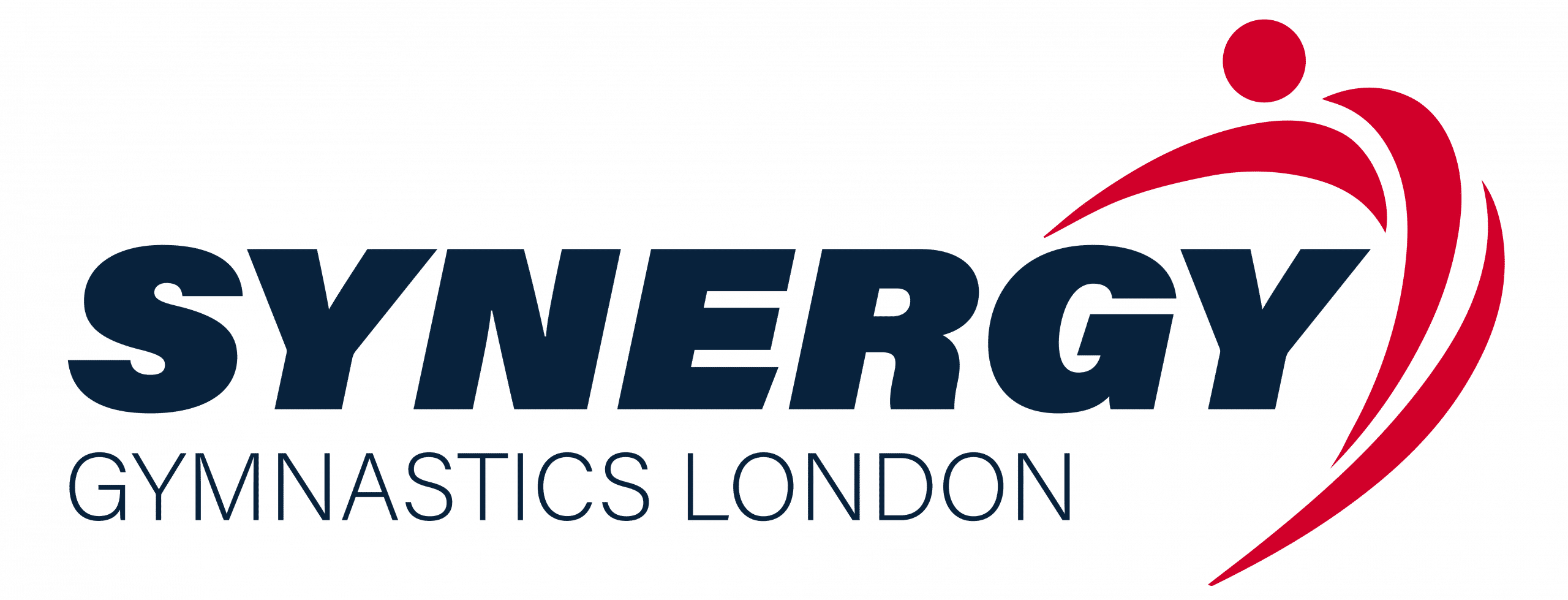Men’s Gymnastics Rings Moves are challenging skills that require immense upper-body strength, technique, and control. Mastering the basic and advanced skills on the rings is a significant achievement for any gymnast. The rings are competed only by male gymnasts in the Artistic discipline but female athletes can also benefit from incorporating Rings into their strength and conditioning routines.
In this article, we’ll provide you with a comprehensive list of basic and advanced still ring moves along with their descriptions.
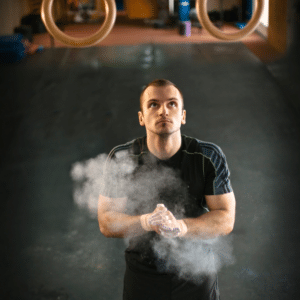
Basic Still Ring Skills
To give this event the correct name – still rings – gives a big clue to the technique needed. That is that the rings should stay as still as possible when being used. This is difficult as the rings are suspended by several meters of cable, or if you are using a set of gymnastics rings at home, they will still have a length of straps. The following skills are considered the basics and lay the building blocks of more advanced skills later on.
Support Hold
The support hold is a basic still ring skill that involves holding your body in an upright position with straight arms and your body parallel to the ground. It is one of the most fundamental skills on the rings and is required for more complex skills.
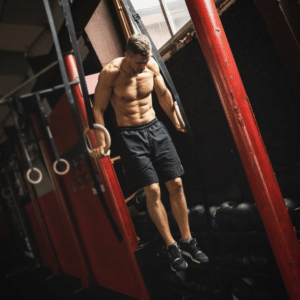
Handstand
The handstand is a fundamental gymnastics skill that involves balancing your body upside down with your arms straight and your hands on the ground. On the still rings, the handstand is performed with the rings close to the body, and maintaining balance requires a significant amount of strength and control.
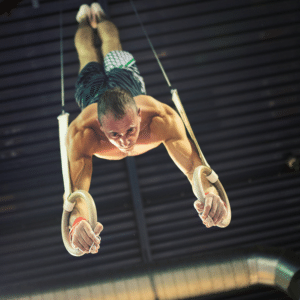
Muscle Up
The muscle up is a foundational still ring skill that involves transitioning from a hanging position to a support position on the rings. This skill requires a combination of strength, technique, and momentum. It’s a great skill to practice at home if you have a set of rings.
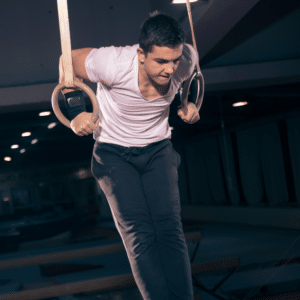
Basic Swing
The basic swing is a skill that involves swinging your body back and forth on the still rings while maintaining control and proper body position.
Kip
The kip is a basic swinging skill that involves the gymnast using their legs to generate momentum and transition from a hanging position to a support position on the rings. This skill is an essential foundation for many of the more advanced skills.
German Hang
The German hang is a still ring skill that involves hanging upside down with your arms wrapped around the rings. This skill requires significant shoulder and arm strength.
Hanging in Tuck
Hanging in tuck is a skill that involves hanging from the still rings in a tucked position with your knees up to your chest. This skill is essential for many advanced still ring skills.
Pike and Straddle Shapes
The pike and straddle shapes are fundamental body positions in gymnastics that are used in still ring skills. The pike shape involves bending at the hips and keeping your legs straight, while the straddle shape involves opening your legs wide apart.
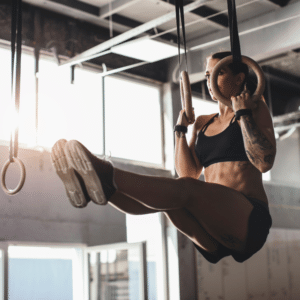
Advanced Rings Skills
The following advanced ring skills require a high level of strength conditioning before they can be mastered. These skills are more challenging than the basic skills and often take years of training to master.
Some may say you can use hacks or tricks to get these skills BUT the reality is you will not be able to master the rings without the correct techniques and progressions.
Back Lever
The back lever is a static hold in which the gymnast is hanging upside down with arms straight, body horizontal and facing upwards. The gymnast must engage their back muscles to keep their body in a straight line and hold the position for a set amount of time.
Back Uprise
The back uprise is a skill that involves the gymnast transitioning from a hanging position to a support position on the rings, without using their legs to assist them. This skill requires a lot of upper-body strength and technique.
Dislocate
The dislocate is a skill where the gymnast swings forward and then performs a backward roll while keeping the rings close to their body. The dislocate requires a great deal of strength, control, and timing to execute properly.
Front Uprise
The front uprise is similar to the back uprise but instead, the gymnast transitions from a hanging position to a support position facing forward. This skill requires strong shoulder and chest muscles.
Iron Cross
The iron cross is an iconic gymnastics skill that involves the gymnast holding their body horizontally while suspended on the rings, with arms extended out to the side in a cross shape. This skill requires incredible upper body strength and control, as well as flexibility in the shoulders and chest.
Delchev
The Delchev is a release move in which the gymnast swings backward and releases the rings, performs a 360-degree turn, and then catches the rings again. This skill requires a lot of power and technique to execute properly.
Flyaway
The flyaway is a dismount skill where the gymnast releases the rings and performs a backflip in the air before landing on the ground. This skill requires excellent technique and spatial awareness.
Back Giant
The back giant is a swinging skill where the gymnast performs a backward swing and then transitions to a forward swing, without their body touching the rings. This skill requires a lot of strength and technique.
Front Giant
The front giant is similar to the back giant but performed in the opposite direction, where the gymnast transitions from a forward swing to a backward swing. This skill requires a great deal of control and timing.
Azarian
The Azarian is a skill that involves the gymnast swinging forward and then performing a half-turn while keeping the rings close to their body. This skill requires a lot of strength and timing to execute properly.
Planche
The planche is a static hold where the gymnast is holding their body parallel to the ground with their arms extended, but without their feet touching the ground. This skill requires incredible upper body strength and core stability, as well as flexibility in the wrists and shoulders.
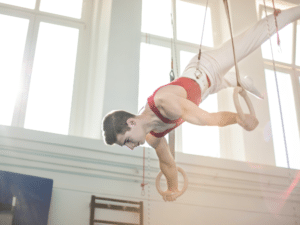
Maltese Cross
The Maltese Cross is a skill where the gymnast holds their body horizontally on the rings with arms extended out to the side in a cross shape, but with their palms facing downwards. This skill is considered one of the most difficult skills in gymnastics, requiring immense strength, control, and flexibility.
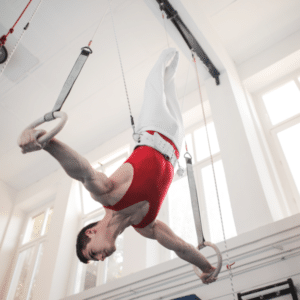
Nakayama
The Nakayama is a swinging skill that involves the gymnast performing a forward giant swing and then releasing the rings and performing a half turn before re-catching the rings. This skill requires a lot of strength, control, and timing to execute properly.
FAQs
What are the rings in gymnastics called?
Gymnastics Rings are called Still Rings as they remain fairly static compared to Flying Rings found in Trapeze. There is some movement of the rings but male gymnasts have to use enormous upper body strength to keep the Rings under control.
Why don’t female gymnasts do rings?
The Rings require high levels of upper body strength, especially around the shoulders, arms and core. Typically this suits male gymnasts and traditionally female artistic gymnasts have been expected to produce more elegant and artistic routines. However, who knows if in the future these traditions will shift!
Can you do dips on gymnastic rings?
Yes, you can do dips on gymnastics rings by lowering yourself from a support position (rings by your hips). You should squeeze the rings into your body as they will try and push away from each other. Doing dips on the rings will improve the strength in your upper body and core.
- How To Get Over a Mental Block In Gymnastics: A Complete Guide
 Gymnastics is a sport that requires not only physical strength and skill but also mental strength. When a gymnast feels like they cannot attempt a… Read more: How To Get Over a Mental Block In Gymnastics: A Complete Guide
Gymnastics is a sport that requires not only physical strength and skill but also mental strength. When a gymnast feels like they cannot attempt a… Read more: How To Get Over a Mental Block In Gymnastics: A Complete Guide - Find The Best Leotard For Girls (Guide)
 Finding an ideal leotard for girls isn’t just about picking a dazzling design that sparkles (although it does help!). The leotard has to fit perfectly,… Read more: Find The Best Leotard For Girls (Guide)
Finding an ideal leotard for girls isn’t just about picking a dazzling design that sparkles (although it does help!). The leotard has to fit perfectly,… Read more: Find The Best Leotard For Girls (Guide) - The Best Gymnastics Shorts (Our Top Picks)
 The best gymnastics shorts are designed to be worn over the top of a leotard providing additional coverage around the upper legs, whilst allowing gymnasts… Read more: The Best Gymnastics Shorts (Our Top Picks)
The best gymnastics shorts are designed to be worn over the top of a leotard providing additional coverage around the upper legs, whilst allowing gymnasts… Read more: The Best Gymnastics Shorts (Our Top Picks) - Decathlon Leotards – Are They Any Good?
 If you’re in the market for a new leotard, you may be wondering if Decathlon leotards are any good considering the low cost of their… Read more: Decathlon Leotards – Are They Any Good?
If you’re in the market for a new leotard, you may be wondering if Decathlon leotards are any good considering the low cost of their… Read more: Decathlon Leotards – Are They Any Good? - A Complete Guide to Gymnastics Hand Rips
 Are you tired of dealing with painful gymnastics rips on your hands from training? Look no further – this article offers a comprehensive approach to… Read more: A Complete Guide to Gymnastics Hand Rips
Are you tired of dealing with painful gymnastics rips on your hands from training? Look no further – this article offers a comprehensive approach to… Read more: A Complete Guide to Gymnastics Hand Rips - Is Gymnastics Dangerous? (Facts and Comparisons)
 Gymnastics is acknowledged as a highly technical and physically demanding sport. It inherently carries a risk of injury, which is why most coaches and clubs… Read more: Is Gymnastics Dangerous? (Facts and Comparisons)
Gymnastics is acknowledged as a highly technical and physically demanding sport. It inherently carries a risk of injury, which is why most coaches and clubs… Read more: Is Gymnastics Dangerous? (Facts and Comparisons)
